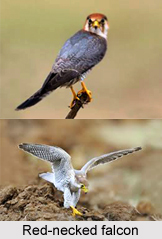 Red-Necked Falcon is an Indian bird that bears a scientific name "Falco chicquera" is a bird of prey in the falcon family with two disjunctive populations, one in India and the other in Africa. Red-necked falcon drinks water where available during the afternoons. This has been observed both in India and in Africa, where it sometimes visits waterholes.
Red-Necked Falcon is an Indian bird that bears a scientific name "Falco chicquera" is a bird of prey in the falcon family with two disjunctive populations, one in India and the other in Africa. Red-necked falcon drinks water where available during the afternoons. This has been observed both in India and in Africa, where it sometimes visits waterholes.
Structure of Red-Necked Falcon
Red-Necked Falcon is the medium-sized falcon that has bluish grey wings and upper body, a chestnut red cap with short chin straps passing through the eye. The primary feathers of the wing are black and a single black band at the tip of the tail is distinctive. The Indian subspecies Falco chicquera chicquera also known as the red-headed merlin or red-headed falcon is found mainly in the open plains of Indian Subcontinent although it is thought to have occurred further west in south eastern Iran. The subspecies Falco chicquera ruficollis found in sub-Saharan Africa is sometimes treated as a full species, the rufous-necked Falcon (Falco ruficollis), on the basis of its well-separated geographic range and distinctive pattern. It appears very similar to the Indian form but has dark barring on the upperparts, a rufous breast band, and black moustachial and eye stripes. As in most falcons, the females are larger and falconers in India called the female turumti and the male as chatwa. They hunt in pairs mostly at dawn and dusk, capturing small birds, bats and squirrels. The legs, ceres and eye-ring of Red-Necked Falcon are yellow.
Sexes of Red-Necked Falcon
Red-Necked Falcons are similar except in size, males are smaller than females as is usual in falcons. Young birds are buff below with less extensive barring and duller upper plumage. The adult of the African subspecies Falco chicquera ruficollis first described by William Swainson in 1837 has a white face apart from black on the moustachial stripe. The upperparts are pale grey, with black primary wing feathers and the broad tail band. The under parts are white with dark barring on the under wings, lower breast, belly and under tail. There is a rufous fore neck band. West African males are known to weigh between 139 and 178 grams, while females are found between 190 and 305 grams. The Asian nominate subspecies Falco chicquera chicquera has rufous moustachial stripes, lacks the buff breast band, and is less extensively barred than the African form.
Concentration of Red-Necked Falcon
In Africa, Red-Necked Falcon is found in semi-desert, savannah and other dry open country with some trees, but also riverine forest. It often perches and makes use of the crowns of Borassus palms for breeding. They are mostly resident but may make nomadic movements in response to weather. In India, they are found in open habitats and are not found in dense forests or high hills. The nominate subspecies is believed to have occurred west until Iran although no records exist from there since 1970.
Prey of Red-Necked Falcon
Red-Necked Falcon usually hunts in pairs, often at dawn and dusk, sometimes utilizing a technique in which one of the pair flies low and flushes up small birds while the other follows higher up and seizes the prey as it flushes from cover. They fly with a fast and dashing flight.
Breeding Season of Red-Necked Falcon
The breeding season in Indian states is from January to March. In Zambia, the breeding season begins in August. Pairs may indulge in courtship feeding in which the female feeds the male, an unusual behaviour that has also been noted in captivity. This falcon often reuses the old tree nests of corvids, or lays its 3-5 eggs in a nest that it builds on the fork of a tall tree or in the crown of a palm tree. In India, the nest of Red-necked falcon is often placed in a large mango tree (Mangifera indica) and concealed inside foliage. The nest territory is well-guarded and crows and kites driven away. The male Red-necked falcon brings food which is torn by the female and fed to the chicks. The young fledge in about 35 to 37 days in Africa and up to 48 days in India.



















